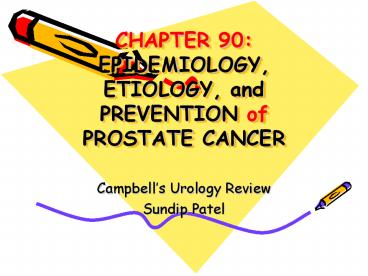CHAPTER 90: EPIDEMIOLOGY, ETIOLOGY, and PREVENTION of PROSTATE CANCER - PowerPoint PPT Presentation
1 / 20
Title:
CHAPTER 90: EPIDEMIOLOGY, ETIOLOGY, and PREVENTION of PROSTATE CANCER
Description:
CHAPTER 90: EPIDEMIOLOGY, ETIOLOGY, and PREVENTION of PROSTATE CANCER Campbell s Urology Review Sundip Patel EPIDEMIOLOGY Most common visceral malignant neoplasm in ... – PowerPoint PPT presentation
Number of Views:128
Avg rating:3.0/5.0
Title: CHAPTER 90: EPIDEMIOLOGY, ETIOLOGY, and PREVENTION of PROSTATE CANCER
1
CHAPTER 90EPIDEMIOLOGY, ETIOLOGY, and
PREVENTION of PROSTATE CANCER
- Campbells Urology Review
- Sundip Patel
2
EPIDEMIOLOGY
- Most common visceral malignant neoplasm in US
men. - Lifetime risk
- 17.6 WHITES 2.8 DEATHS
- 20.6 AFRICAN AMERICANS 4.7 DEATHS
- Annual Death rates 30/100,000
3
EPIDEMIOLOGY
- Worldwide , prostate cancer is 4th most common
male malignant neoplasm - Lowest rate is in Asia (1.9/100,000)
- Highest in North America and Scandinavia, esp AA
(272/100,000) - CaP rarely diagnosed in men lt50.
- Peak incidence b/w 70-74 years
- 85 diagnosed after age 65 years
4
EPIDEMIOLOGY
- Now, a more favorable stage at presentation
- Incidence of local regional disease is increased,
metastatic disease incidence is decreased. - Non-palpable cancers account for 75 of newly
diagnosed disease - Thus, 5/10 year survival rates improved
- Effects on mortality - controversial
5
RISK FACTORS
- Genetic and environmental influences
- GENETIC INFLUENCES
- Risk increased according to number of affected
family members, relatedness, age of infliction - Hereditary FORM
- If dx at lt55y/o stronger familial clustering
number of family members and age of onset is most
important
6
EPIDEMIOLOGY
- GENES
- HPC1 best cited RNase L enzyme Type I
interferons, 2-5A synthetases, R462Q, Arginine to
Glutamine substitution - HPC1 autosomal dominant with high penetrance
- SR-A/MSR MIC1 --- MEDIATORS OF InflamaTION
- PON1
- CHEK2/BRCA2/OGG1 --- DNA REPAIR
7
Inflammation, infection, genetic susceptibility
- Prostate cancer may be associated with hx of STD
or prostatitis - Proliferative inflammatory atrophy are frequent
in prostate specimens - Compromised cellular defenses against
inflammatory oxidants may initiate and perpetuate
prostatic carcinogenesis
8
Molecular Epidemiology
- Androgens
- Affects proliferation and differentiation of
luminal epithelium - Long term ABSENCE of androgens are protective
- Estrogens
- Could be protective or teratogenic
- Phytoestrogens may be beneficial
9
Molecular Epidemiology
- Insulin Like Growth Factor Axis
- IGF-1 inhibits apoptosis in normal prostate
- Its protein, IGFBP-3 can be cleaved by PSA,
reducing its pro-apoptic activity - Leptin
- Produced by adipocytes
- Stimulates DU145 and PC3 prostate cancer cell
lines
10
Molecular Epidemiology
- Vitamin D in relation to cancer risk (protective)
- Higher CaP mortality rate in men living in
northern latitudes - Occurs more frequently in older men
- African Americans have the highest worldwide
incidence - Increased dairy intake assoicted with prostate
cancer - Native Japanese high vit D diet- have low
incidence of prostate cancer
11
Epidemiology
- Sexual Activity
- Unknown effect
- Vasectomy
- Predispostion to cancer
- Smoking
- Risk factor for prostate cancer
- Diet
- Strong effect on CaP
12
Epidemiology
- Dietary Fat
- Polyunsaturated fat consumption correlated highly
with prostate cancer - Obesity
- INC BMI demonstrate oxidative stress
- Lower PSA concentrations in higher BMI patients
- Alcohol
- 1-3 glasses of red wine may be protective
13
Etiology and Molecular Genetics
- CaP exists in 2 forms
- Histologic similar prevalence worldwide
- Clinically Evident Form prevalence variable
- Androgen Influence
- 1o androgen is DIHYDROTESTOSTERONE
- Testosterone ? type 2 5a-Reductase ?
Dihydrotestosterone - Insufficient exposure to DIHYDROTESTOSTERONE is
protective
14
Etiology and Molecular Genetics
- Stem Cells
- Likely exist and are being researched for both
prevention and therapeutic purposes - Epigenetic change
- Involves a change in expression without altering
the actual DNA - Methylation, chromatin remodeling, histone
modification, RNA interference
15
Etiology and Molecular Genetics
- Cyclooxygenase Cox-2
- Enzymes that help produce prostaglandin, which is
used during an inflammatory response - Prostate cancers express more Cox-2
- NSAIDS inhibit COX-2 expression and may be
protective
16
Etiology and Molecular Genetics
Somatic Mutations Associated with Tumor
Initiation and Progression
- Androgen receptor
- NKX3-1
- PTEN
- Classical Oncogenes
- Telomerase
- Glutathione S-Transferase
- P27
- Vascular Endothelial Growth Factor
- E-Cadherin
- ?-Methylacyl-CoA Racemase
17
Etiology and Molecular Genetics
- Prostate Specific Membrane Antigen
- Possible immunotherapeutic agent
- Epidermal Growth Factor
- Associated with prostate cancer
- EZH2
- Increase during CaP progression
18
CHEMOPREVENTION
- Prostate Cancer Prevention Trial
- Tested hypothesis that treatment with finasteride
prevents prostate cancer - 19000 men with normal DRE and PSA were randomly
assigned to daily medication vs placebo - Trial stopped 15 months early
- Risk reduction of 25 reached in medication arm
19
CHEMOPREVENTION
- Antioxidants and Selenium and Vitamin E
- Selenium can decrease the risk of prostate cancer
- Vitamin E a-tocopherol
- Major lipid-soluble antioxidant in cell membranes
- Proposed to induce cell cycle arrest and direct
antiandrogen activity
20
CHEMOPREVENTION
- Soy
- Have isoflavones which inhibit prostatic
epithelial cell growth, downregulate androgen
genes, and reduce tumor growth - Lycopene
- Potent antioxidant activity
- Mixed evidence of lowering risk of prostate
cancer - Green Tea
- Inferred to help prevent prostate cancer based on
low incidence among asian men with higher intake
of green tea































